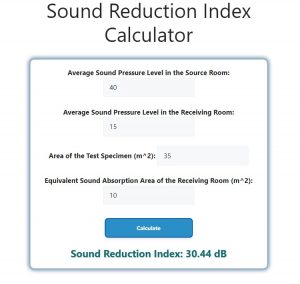About Sound Reduction Index Calculator (Formula)
The Sound Reduction Index (SRI) is a measure of how effectively a material can reduce sound transmission through it. It’s essential for architects, engineers, and designers to evaluate the SRI of walls, windows, and other building materials to ensure proper acoustic insulation in buildings. The higher the SRI value, the better the material is at blocking sound. A Sound Reduction Index Calculator simplifies this complex calculation, helping you find the right materials for soundproofing.
Formula
The formula to calculate the Sound Reduction Index (SRI) is:
SRI = 10 × log10 (1 / (Σ(10^(-TLi/10) × Ai) / ΣAi))
In this formula:
- TLi is the Transmission Loss at a particular frequency
- Ai is the area of the material in square meters
- The summation is done over all components of the material or assembly.
How to Use
- Identify the Transmission Loss (TLi): Measure or obtain the transmission loss values for the material or structure at different frequencies.
- Determine the Area (Ai): Calculate the area of each material in square meters.
- Use the Formula: Apply the values in the SRI formula to calculate the overall sound reduction index.
- Summation: Sum up the values of (10^(-TLi/10) × Ai) for each frequency and material component.
- Final Calculation: Divide by the total area, apply the logarithm function, and multiply by 10 to get the SRI.
Example
Suppose you are calculating the SRI for a wall made of two materials, Material A and Material B.
- Material A has a Transmission Loss of 40 dB and an area of 15 m².
- Material B has a Transmission Loss of 35 dB and an area of 10 m².
First, calculate the value for each material:
For Material A: 10^(-40/10) × 15 = 0.0015 × 15 = 0.0225
For Material B: 10^(-35/10) × 10 = 0.00316 × 10 = 0.0316
Sum these values: 0.0225 + 0.0316 = 0.0541
Total area: 15 m² + 10 m² = 25 m²
Now, apply the SRI formula:
SRI = 10 × log10 (1 / (0.0541 / 25)) = 10 × log10 (1 / 0.002164)
SRI ≈ 36.6 dB

FAQs
1. What is a Sound Reduction Index Calculator?
A Sound Reduction Index Calculator helps determine the soundproofing capability of materials by calculating the SRI using transmission loss data.
2. What does a higher SRI value indicate?
A higher SRI value means better sound insulation, as the material is more effective at blocking sound transmission.
3. Can I use the calculator for multiple materials?
Yes, the calculator can be used for multiple materials by summing up their transmission loss and area values.
4. What is transmission loss?
Transmission loss (TL) measures how much sound is reduced when passing through a material.
5. How is sound measured in decibels?
Sound is measured in decibels (dB), which is a logarithmic scale used to quantify sound intensity.
6. Can this calculator be used for windows?
Yes, the Sound Reduction Index Calculator can be used for any building component, including windows, walls, doors, and more.
7. What is the difference between SRI and STC (Sound Transmission Class)?
STC is a rating of how well a building partition attenuates airborne sound, while SRI is a more detailed index that considers specific frequencies.
8. What frequencies are important in SRI calculations?
Low, mid, and high frequencies are all important, as different materials block different sound frequencies to varying degrees.
9. Can the calculator be used for exterior walls?
Yes, it is ideal for exterior walls to evaluate how much noise can enter a building from outside.
10. How accurate are SRI calculations?
SRI calculations are accurate when you have reliable data for transmission loss and surface area of materials.
11. Can I use the calculator to compare different materials?
Yes, you can compare the SRI of different materials to choose the most effective one for your soundproofing needs.
12. What is the typical SRI value for residential walls?
Residential walls usually have an SRI between 30-50 dB, depending on the construction and materials used.
13. How do I find the transmission loss (TLi) for a material?
The TLi for a material can usually be found in manufacturer specifications or determined through sound testing.
14. Is the SRI value the same for all frequencies?
No, SRI values vary across frequencies. Materials may block high frequencies better than low frequencies or vice versa.
15. What is a good SRI for a recording studio?
A good SRI for a recording studio is typically above 50 dB to ensure high levels of sound insulation.
16. How can I increase the SRI of a wall?
You can increase the SRI by adding mass (thicker walls), decoupling layers, or using sound-absorbing materials like insulation.
17. What is the difference between airborne and impact sound?
Airborne sound is noise that travels through the air, like voices or music. Impact sound comes from physical contact, like footsteps or dropped objects.
18. Can I use this calculator for industrial noise control?
Yes, the Sound Reduction Index Calculator is highly useful for industrial noise control applications.
19. Is there a difference between SRI for soundproofing and sound absorption?
Yes, SRI measures how well a material blocks sound, while sound absorption measures how well a material reduces sound within a space.
20. Can soundproofing be achieved without high SRI materials?
While high SRI materials are the most effective for soundproofing, combining materials with different properties can also reduce sound transmission.
Conclusion
The Sound Reduction Index Calculator is a valuable tool for anyone involved in soundproofing or acoustical design. By using this calculator, you can accurately determine how much sound different materials will block, ensuring you choose the right ones for your project. Whether you’re building a home, office, or industrial facility, understanding the SRI of your materials helps in creating quieter, more comfortable environments.